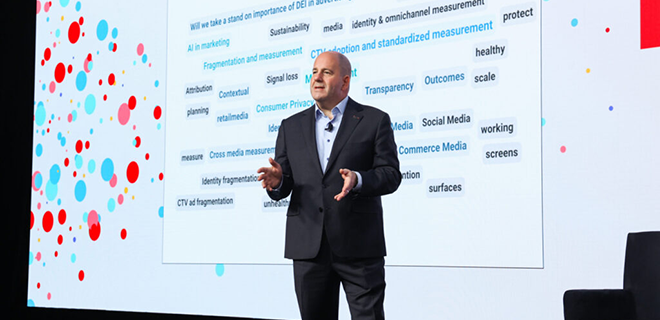
At IAB ALM 2025, leaders dissected the future of advertising, from AI’s rapid evolution to the open web’s fragile state. Here are seven takeaways shaping the industry’s next moves.
Photo Credit: The IAB
Another IAB Annual Leadership Meeting has passed. One thing that rang loudly and clearly in Palm Desert was that adaptation isn’t optional—it’s survival.
Whether it was the Trade Desk’s Jeff Green sounding the alarm on the open internet, General Motors’ Shenan Reed (New IAB Board Chair) championing advertising’s role in storytelling, or Ron Howard waxing poetic about AI’s creative potential—there was a consistent message…evolve or risk irrelevance.
Conversations across the board wove through AI’s double-edged sword, the fragmentation of CTV, and the persistent tension between walled gardens and the open web. Here are seven things that stuck with me long after the sessions wrapped.
1. AI Is More Than Just Another Tool—It’s the New Creative Partner
As a surprise to hardly anyone in the advertising ecosystem, AI was the unofficial headliner at ALM. Yet, this time it wasn’t just the buzzword you hate to keep hearing about, it came across as a tangible industry force built to reshape creativity.
From Meta’s multimodal AI tools enhancing content creation to Google’s Gemini streamlining SMB advertising, AI is creeping out from a backend assistant to a front-row collaborator. As Ron Howard shared, AI doesn’t replace creativity, it’s stretching its boundaries. But, before we get lost in the glitter of AI’s alluring potential, let’s remember that its usage comes with heapings of ethical and practical implications.
2. The Open Web’s Survival Depends on Staying… Well, Open
IAB CEO David Cohen’s keynote was a wake-up call grounded in historical context. He likened the risks of today’s digital consolidation to the historical blunders driven by isolationism. The mid and long tail of the web is shrinking, and that’s a problem for the entire ecosystem—not just publishers.
Competition breeds innovation. Without it, we’re left with monopolies disguised as progress. The open web thrives on transparency, interoperability, and yes, advertising. Protecting it is about collective accountability just as much as policy.
3. Retail Media’s Growth Is Outpacing Its Measurement Tools
Retail media networks might be booming, but its measurement capabilities…? They’re still out on the field playing catch-up. Randolph Browning from Night Market stressed the need to move beyond ROAS to incremental ROI (iROI). Traditional metrics aren’t cutting it, especially when commerce is pervasive across physical, digital, and contextual spaces.
If brands want to future-proof their strategies, they need data partnerships that close gaps and tools that offer real-time, actionable insights—not just pretty dashboards.
4. CTV’s Growing Pains: Mo’ Ads, Mo’ Problems?
Stop calling CTV, TV with better targeting. It has long moved past that into a full-funnel beast, and guess what, it’s hungry. Jeff Green’s fireside chat drove home that point when he said we can expect more ad loads and a surge in biddable inventory.
The push for profitability means more ads, but the real win is not in making those ads more frequent, it’s in making them smarter. Programmatic will remain key here, especially in live sports, where biddable inventory could be the MVP for revenue growth.
5. News Media Isn’t Dying—It’s Evolving (If We Let It)
The “Spotlight on News” panel focused on the news media’s transformation. Bloomberg Media’s Christine Cook explained that news consumers aren’t disappearing—they’re just diversifying where they get their information.
Trust is still the currency, but how we build and maintain it requires new thinking. Whether through AI-driven summaries, curated communities, or redefining what counts as news, the media landscape is shifting. The key? Embracing experimentation without sacrificing journalistic integrity.
6. The Industry’s Fragmentation Is Both the Problem and the Opportunity
Whether it’s identity in CTV, data in retail media, or the fractured state of ad tech stacks, fragmentation was a recurring theme. But fragmentation should not be viewed as just a hurdle—it’s also a catalyst.
It forces collaboration, innovation, and the breaking down of outdated silos. As Shenan Reed said, “Advertising done well is a service to the customer.” And doing it well means connecting the dots, not just collecting them.
7. The Human Connection Remains the Ultimate KPI
With all the talk about AI, data, and automation, one recurring theme stood out—the technology is only as powerful as the human connections it supports. Whether through fan engagement strategies, authentic brand storytelling, or the persistent value of trusted news sources, the endgame is clear—connection.
Brands that remember the “why” behind the “what” will be the ones to not only survive but thrive in the ever-evolving landscape.
What This All Means for the Road Ahead
There’s no time for complacency in this industry. Whether through AI, data, or creative reinvention, the future belongs to those who aren’t afraid to challenge the status quo. So, what’s your next move?